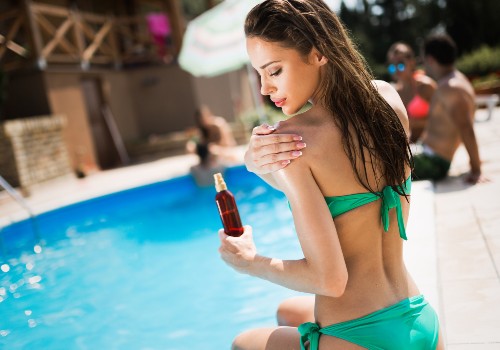You want the gorgeous, natural glow that goes hand-in-hand with a suntan.
But you don’t want to spend hours roasting under the sun (and absorbing harmful UV rays) to get it.
Sound like you? If so, then prepare to meet your new soulmate: tan accelerator.
Here’s the lowdown on this indispensable, oft-misunderstood product — and how to make the most of it.
What Is a Tan Accelerator?

A tan accelerator is a spray, cream or lotion that does exactly what its name suggest: speeds up the tanning process.
It’s not the same thing as a self-tanner, which works by causing a chemical reaction that darkens your dead skin cells.
Rather, a tan accelerator boosts your body’s natural processes to make you tan faster and enhance your glow.
How Does a Tan Accelerator Work?
Tan accelerators work by increasing your skin’s melanin production.
Melanin is the compound responsible for giving your skin color. It’s activated in response to sunlight, which is why we become freckled or tanned after being in the sun.
A tan accelerator makes your body produce more melanin when exposed to the sun. The more melanin you have, the darker your skin appears, meaning that you can get a darker tan in less time if you use a tan accelerator.
Typically, a tan accelerator contains a compound called L-tyrosine, a major component of melanin. With extra L-tyrosine on deck, your body can easily produce more melanin than it would on its own.
Many tan accelerators also contain antioxidants, vitamins, and essential fatty acids. These ingredients help to protect your skin from sun damage, speed up healing, and promote overall skin health.
Some even contain enough UV-blocking ingredients to earn an SPF rating, so they function as sunscreen in addition to tan accelerator.
Additionally, tan accelerators often contain moisturizing ingredients to prevent your skin from drying out in the sunlight. Hydrated skin is more resilient against sun damage and is able to produce more melanin than dehydrated skin.
All of these effects combine into a superpowered product that will make your tanning session quicker, safer and more efficient.
When Should I Use Tan Accelerator?

Tan accelerator is most effective if you plan ahead for your tan.
Your skin needs a little time to amp up its melanin production, so it’s best to start applying tan accelerator at least two weeks before your intended tanning session.
For those seeking a start-of-summer tan, this means beginning your tan accelerator regimen in the spring, even if you don’t plan on going in the sun for a while.
If you’re on a time crunch, you can apply tanning accelerator right before your tanning session and still see results. However, they won’t be as pronounced as they would be if you applied it ahead of time.
Do Tan Accelerators Also Include Fake Tan?
Most tan accelerators do not contain fake tan. Rather than changing the pigment of your dead skin cells, they focus on boosting your skin’s natural tanning abilities.
However, some tan accelerators do contain self-tanner or bronzer to provide an instant dose of color while preparing your skin for a more organic tan.
How Do I Use Tan Accelerator?
As discussed, tan accelerator works best if you apply it every day for several weeks before your big tanning session.
During these few weeks, apply your tan accelerator every evening after you’re done with sun exposure for the day. This gives you a nice pre-tan and prepares your skin for a big melanin increase.
When you’re ready to tan, apply your tan accelerator right before heading outside or going to the tanning salon. Reapply it after your session to ensure continuing melanin production.
Once you’re satisfied with your tan, you can maintain it by continuing to apply your tan accelerator every evening. This will prolong your tan and keep it smooth, even and glowing long after you leave the sun.
What Is the Best Natural Tan Accelerator?
If you’re not enthused by the idea of using a chemical-filled tan accelerator, try one of these natural options. They’ll help you get that beautiful glow without coating your skin in mystery ingredients.
Olive Oil Tan Accelerator
Olive oil is a pantry staple, and it’s about to become your new skincare staple, too. This simple olive oil tan accelerator recipe will have you looking bronzed and beautiful in no time.
As a base ingredient, olive oil enhances your skin’s moisture barrier and supplies it with antioxidants to protect against sun damage.
Just mix 5 ounces of olive oil with 5 drops each of tincture of iodine and carrot juice. Tincture of iodine is a sun protectant, while carrot juice speeds up the tanning process.
Coconut Oil Tan Accelerator

If you haven’t tried using coconut oil on your skin before, prepare to be pleasantly surprised.
Coconut oil has long been championed as a natural moisturizer. It prevents the sun’s harsh rays from drying your skin out as you tan.
Hydrated skin tans much faster than dehydrated skin, so if you coat yourself in coconut oil, you’ll get that perfect glow in a fraction of the time.
Best of all, coconut oil triggers your body’s melanin production in much the same way as commercial tanning accelerators.
It may not be as fast or powerful as store-bought products, but it’s all natural and has many other health benefits beyond tanning.
Commercial Tanning Oils
If you don’t want to make your own tanning oil but don’t want to use a chemical tan accelerator, you still have options!
Commercially-available tanning oils aren’t quite the same as tan accelerators. They enhance and often speed up your tan, but they don’t react directly with your melanin cells the way tan accelerators do.
Most commercial tanning oils contain essential oils and plant extracts to naturally hydrate, protect and enhance your skin. Oils also attract UV rays, helping you tan faster.
Tanning oils come in a diverse array of scents that are sure to please those who hate the smell of chemical skincare products. Look for oils that contain moisturizing and cooling ingredients like aloe vera to prevent sunburn and overdrying.
Just make sure to wear sunscreen in addition to your tanning oil to reduce your risk of sun damage. Even oils that contain SPF usually don’t supply it in high enough concentrations — you need at least SPF 30 to get full protection.

